
Department of Plastic and Reconstructive Surgery, Graduate School of Medicine, Hokkaido University
Yuhei Yamamoto, M.D., Ph.D.Specialized Medicine
- Education:
-
- 1984: M.D. cum laude, Hokkaido University, School of Medicine
- 1995: Ph.D. Hokkaido University, School of Medicine
- Professional Training and Employment:
-
- 1984-85: Resident in Plastic and Reconstructive Surgery, Hokkaido University, Sapporo, Japan
- 1986-95: Fellow in Plastic and Reconstructive Surgery, Hokkaido University, Sapporo, Japan
- 1991-92: Fellow in Plastic Surgery, University of Alabama, Birmingham, U.S.A.
- 1995-2003: Assistant Professor in Plastic and Reconstructive Surgery, Hokkaido University, Sapporo, Japan
- 2003-2005: Associate Professor in Plastic and Reconstructive Surgery, Hokkaido University, Sapporo, Japan
- 2005-present: Professor and Chairman in Plastic and Reconstructive Surgery, Hokkaido University, Sapporo, Japan
- 2007: Inviting Professor in Plastic and Reconstructive Surgery, Zhongshan Hospital, Fudan University, Shanghai, China
- 2008: Visiting Professor in Plastic and Reconstructive Surgery, University of Alabama, Birmingham, U.S.A
- Awards:
-
- 2001: Japanese Society of Plastic and Reconstructive Surgery Best Article in Clinical Study Award
The Board of Plastic Surgery’s mission is to provide high-quality medical care and promote basic and applied studies.
 “Those who wish to not only provide medical care but also conduct thorough research on plastic surgery are welcome to join our department,” says Professor Yuhei Yamamoto, who has led Plastic and Reconstructive Surgery since 2005. He adds that one of the missions imposed on plastic and reconstructive surgeons is to provide highly advanced medical treatment and treatment meeting high standards to patients, while another is to recognize plastic and reconstructive surgery as an academic art, thereby unwaveringly promoting both basic and clinical studies as a researcher.
“Those who wish to not only provide medical care but also conduct thorough research on plastic surgery are welcome to join our department,” says Professor Yuhei Yamamoto, who has led Plastic and Reconstructive Surgery since 2005. He adds that one of the missions imposed on plastic and reconstructive surgeons is to provide highly advanced medical treatment and treatment meeting high standards to patients, while another is to recognize plastic and reconstructive surgery as an academic art, thereby unwaveringly promoting both basic and clinical studies as a researcher.
Constantly obtaining competitive funds from Japan’s Ministry of Education, Culture, Sports, Science and Technology as well as other organizations, the professor has carried out basic and clinical research in five major disciplines – wound therapy, facial nerve, malignant skin tumor, lymphatic tissue and regenerative medicine – among a wide range of plastic and reconstructive surgery research fields. He has also leveraged all of the findings gained through research on these disciplines to address various clinical issues.
 Wound therapy is a research field in which the department has been involved for ten years. Based on the concept of Complete Healing of Stubborn Wounds, this field focuses on research on various issues including skin suture methods that leave no scars, mechanisms behind the way stubborn wounds (e.g., skin exposed to radiation, bedsores, diabetic ulcers) heal completely, as well as pathological conditions and treatment of keloids formed in scarred tissue such as scalds or ulcers. Facial nerve research encompasses the verification of facial nerve reconstructive operations and medication via mouse models with facial nerve palsy from the perspectives of cerebral physiology, muscular physiology and electrophysiology.
Wound therapy is a research field in which the department has been involved for ten years. Based on the concept of Complete Healing of Stubborn Wounds, this field focuses on research on various issues including skin suture methods that leave no scars, mechanisms behind the way stubborn wounds (e.g., skin exposed to radiation, bedsores, diabetic ulcers) heal completely, as well as pathological conditions and treatment of keloids formed in scarred tissue such as scalds or ulcers. Facial nerve research encompasses the verification of facial nerve reconstructive operations and medication via mouse models with facial nerve palsy from the perspectives of cerebral physiology, muscular physiology and electrophysiology.
Malignant skin tumor, which Professor Takehiko Ohura (current Professor Emeriti of Hokkaido University; the first professor of the department) specializes in, is a research field the department has engaged in since the 1970s. This field focuses, from a molecular biological viewpoint, on clarifying the mechanisms behind the spread of malignant melanoma, which is said to be difficult to treat as it is the most malignant of skin cancers. In addition, research on malignant skin tumor is being linked with research on lymphatic tissue such as lymphatic edema. The department has elucidated from a molecular biological perspective that melanoma is liable to spread to portions with lymphatic edema. It also carries out studies on the reconstruction of lymphatic tissue removed together with cancerous tissue.
Regenerative medicine is the research field the department has embarked on most recently. In particular, one of the breakthrough studies is that on applying stem cells derived from the amniotic membrane of delivered placenta at birth to breast reconstruction after the removal of breast cancer as well as to nerve reconstruction and the treatment of keloids. “Amniotic stem cells, which have a high regenerative capacity, release growth factors such as cytokine in high quantities. This is why they are extremely instrumental in boosting the efficiency of fat graft survival in a reconstructed breast.”
The four years spent at graduate school translate to no more than a tenth of a doctor’s life-long career.

These above-mentioned studies have been conducted by doctors who have identified clinical hurdles and themes to be addressed by themselves based on several years of clinical experience. “Clinical departments assume responsibility for fostering graduate students who conduct both basic and clinical studies with the aim of applying research achievements to clinical care. In our department, each student independently conducts basic research as well as learns about state-of-the-art molecular biological experiment methods by participating in conferences directed by departments involved in basic research. Needless to say, this creates an environment suitable for pursuing clinical research. We provide instructions for those who are engaged in collating multiple cases while performing advanced plastic surgery as an assistant, and wishing to analyze patients’ data in order to announce results at conferences and present them in papers,” says Professor Yamamoto.

“University hospitals are places where doctors perform the most difficult operations and cutting-edge medical treatments, while graduate schools are environments where researchers take responsibility for developing studies to pass down their findings to the next generation. They are required to determine their specialty by understanding basic research and obtaining public recognition on clinical results through presentations at conferences and the publication of papers, which is the first step for the Board of Plastic Surgery. The graduate school is perfect for those who are too busy to spare time for research. The four years spent in the doctoral course of the graduate school is no more than a tenth of a doctor’s life-long career.”
Until now, three staff doctors have acquired positions as professors at other universities and have left the nest under the auspices of Professor Yamamoto, who says, “Cultivating university leaders is also one of our department’s roles. Research results gained from both basic and clinical studies serve as the requirements necessary to become a leader. I am proud that our department has fulfilled its commitment.”
(Interviewed in January 2019)
Who will be the winners of the Hokusei Prize at the UHS PRS Academy?

The UHS PRS Academy, an educational forum and workshop, is held twice a year (in spring and autumn) as an opportunity for department members to make presentations on their excellent basic and clinical studies, inviting researchers who are playing an active role in other institutions. The event in spring highlights the Hokusei Prize Awarding Ceremony to praise research achievements made by department members throughout the year, as well as their commemorative lectures. The prize consists of five divisions. The prize in the research paper division goes to an individual who has gained the highest impact factor value throughout the year in basic and clinical studies respectively and who has completed a superb paper, the prize in the researcher division goes to an individual who has completed the largest number of papers of all members, and that in the young researcher division goes to an excellent young researcher. This prize serves as a driving force to motivate department members to work hard with each other and cultivate the capacity to perform research.


